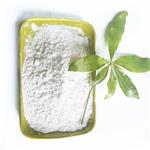Description
3,3'-Dihydroxybenzidine is an organic synthesis intermediate used as a raw material for the synthesis of fire-resistant polymers (polyhydroxyamino acids).3,3'-Dihydroxybenzidine is also used in the preparation of hydroxyl-containing polyimides, all of which are synthesised to be soluble in NMP when heated. 3,3'-Dihydroxybenzidine is used in the synthesis of polyimides with hydroxyl groups. The glass transition temperature (Tg) of polyimides ranges from 336-360°C, independent of the structure of the tetracarboxylic dianhydride. The storage modulus of some polyimides does not decrease at elevated temperatures. All polyimides thermally transform into polybenzoxazole when heated to 500°C for 1 hour under vacuum.
Chemical Properties
A pale brown solid
Uses
4,4'-diaminobiphenyl-3,3'-diol is used as organic intermediates.
Uses
3,3''-Dihydroxybenzidine is used in preparation method of covalent organic framework-based metamaterial for optical device.
General Description
Colorless crystals.
Air & Water Reactions
Keep well closed. Protect from air and light.
Reactivity Profile
3,3'-Dihydroxybenzidine is an aminoalcohol. Amines are chemical bases. They neutralize acids to form salts plus water. These acid-base reactions are exothermic. The amount of heat that is evolved per mole of amine in a neutralization is largely independent of the strength of the amine as a base. Amines may be incompatible with isocyanates, halogenated organics, peroxides, phenols (acidic), epoxides, anhydrides, and acid halides. Flammable gaseous hydrogen is generated by amines in combination with strong reducing agents, such as hydrides.
Health Hazard
ACUTE/CHRONIC HAZARDS: When heated to decomposition 3,3'-Dihydroxybenzidine emits toxic fumes.
Safety Profile
Suspected carcinogen
with experimental carcinogenic,
neoplastigenic, and tumorigenic data.
Mutation data reported. When heated to
decomposition it emits toxic fumes of
Nox






